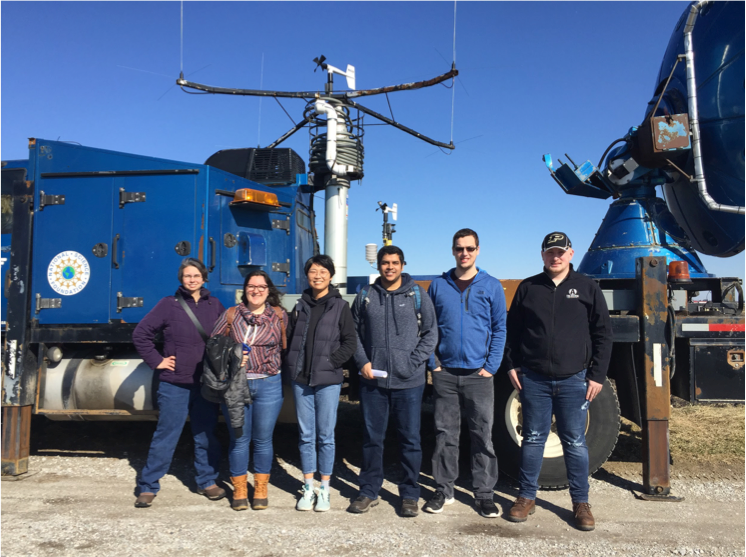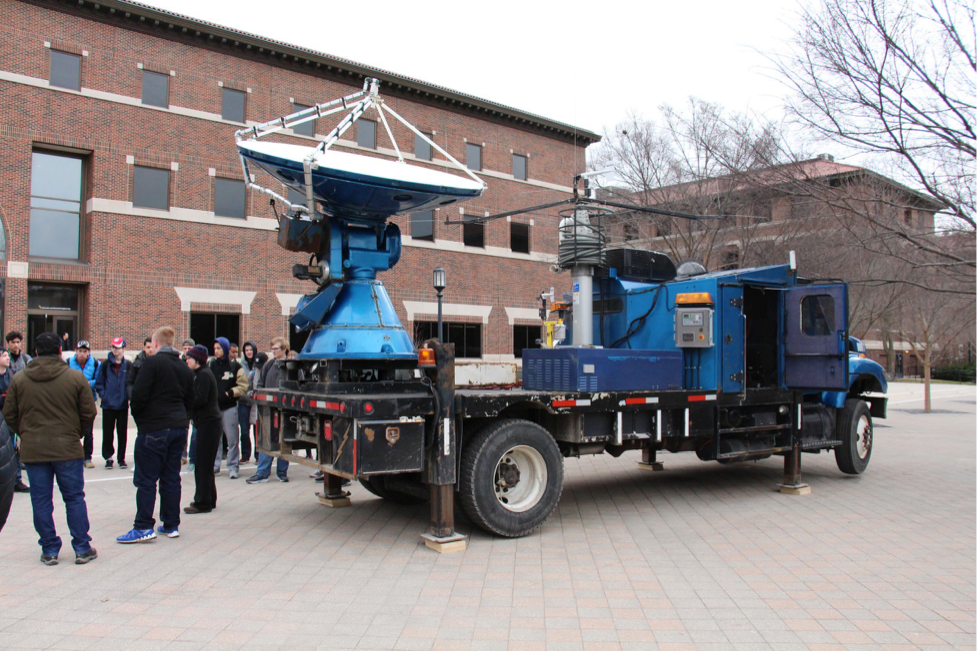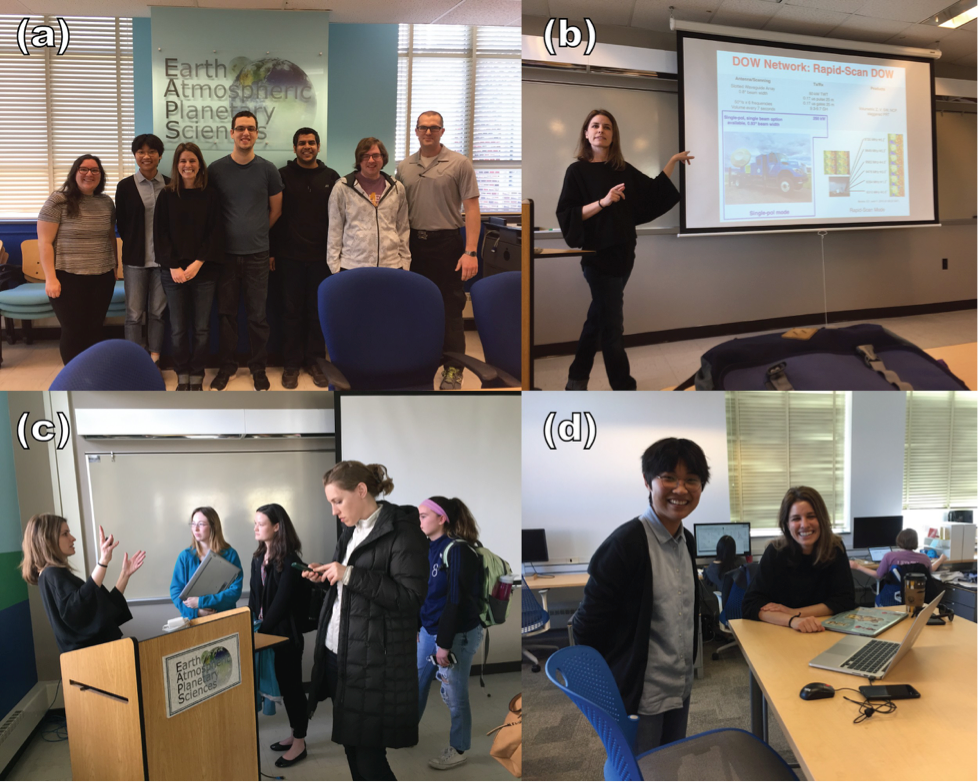EAPS 52300: Radar Meteorology
PurRad was timed to coincide with Indiana’s winter-to-spring transition. A wide variety of weather, ranging from snow to tornadic storms, have historically been observed during this period. After reading and discussing Kumjian et al. (2013), four graduate students enrolled in Radar Meteorology identified three atmospheric phenomena to target for detailed case studies: (1) the polarimetric refreezing signature; (2) the melting layer signature; and (3) differential reflectivity (ZDR) columns in convective storms. The phenomena were selected to align with both the expected range of weather conditions and the individual students’ interests. By focusing on three distinct atmospheric phenomena instead of one, the class proactively hedged against the failure to collect observations of one or more of the phenomena. As it turned out, owing to a lack of strongly convective storms in Indiana, no suitable observations of ZDR columns were collected. Accordingly, the students’ DOw-based projects were focused primarily on identification of melting layers and refreezing signatures.
During the experiment design, it was noted that studies of all three of these phenomena would benefit from local observations of the 0 °C height. As Purdue University is located 230 km from the nearest operational National Weather Service upper-air sounding site (Springfield, Illinois; KILX), the students requested the use of a mobile sounding system to collect local atmospheric soundings during deployments. Prof. Michael Baldwin (EAPS) instructed the students on how to launch radiosondes. Owing to an equipment failure, sonde flights were only successful in one case.
The six EAPS 52300 participants (Fig. 4) and the CSWR staff members (A. Gilliland and M. Hanshaw, Fig. 5) developed a set of scanning strategies for each type of mission that involved surveillance scans (PPIs) from 4° to 20° for melting layer observations, 0.5° to 4° for refreezing signatures, and vertical scans (RHIs) for ZDR columns. Fortunately, the DOW scan scheduling software was versatile enough to handle combinations of the above with just a few mouse clicks.
The group monitored forecast model updates and designated Intensive Observing Periods (IOPs), during which the DOW was deployed with at least one student assisting in operation, logging, and curation of the data. Throughout the deployment, the PI, students, and CSWR staff communicated using the social media site GroupMe. Each day, the PI initiated a daily forecast discussion, soliciting input from the other participants. If an IOP was deemed necessary, the chat was used to coordinate deployment, crewing, and scanning strategies. A total of four IOPs were conducted (Table 1), along with a “0th” IOP (ground clutter survey) that occurred early in the deployment.
Following each IOP, A. Gilliland curated and converted all of the DOW data into DORADE format, collected all of the associated logs, mesonet data, and inclinometer data, and transmitted them to the PI. The PI then further converted the DOW data into Cf/Radial format, added sounding data to the archive when it was available, and posted it on Purdue servers for access by the students. Students analyzed these data using both Solo II (NCAR 2016) and Py-ART (Helmus and Collis 2016) software. As there were four registered students and four IOPs, one IOP was assigned to each students as a case study. Each student was tasked with producing quasi-vertical profiles (QVPs; Ryzhkov et al. 2016) and applying a hydrometeor classification algorithm to the raw DOW observations.
| IOP | Date/Time | Mission | Conditions/comments |
| 0 | 28 February 2018, 1500 - 1600 UTC | Training, clutter survey | Distant light rain, otherwise quiescent conditions. |
| 1 | 1 March 2018, 1300 - 1800 UTC | Melting layer | Cold FROPA. Sonde data collected (3). |
| 2 | 5 March 2018, 2200 UTC - 0230 UTC | Refreezing signature | Warm FROPA. |
| 3 | 6 March 2018, 1900 - 2200 UTC | Refreezing signature | Graupel and snow. |
| 5 | 17 March 2018, 0200 - 0900 UTC | Melting layer and refreezing signature | Warm FROPA and freezing rain. |
DOW demonstration deployments on Purdue campus
The DOW was displayed on Purdue campus on 5, 6, and 7 March 2018. The DOW was parked in a high foot-traffic area near Purdue’s iconic Engineering Mall (Figs. 1, 20), and attracted a great deal of attention from passersby.
EAPS classes were invited to tour the DOW and ask questions of the CSWR staff and class participants. Classes that visited included EAPS 13800: Thunderstorms and Tornadoes (96 students, Fig. 1, 23), EAPS 43100: Synoptic Laboratory I (50 students), EAPS 434: Weather Analysis and Forecasting (12 students), and EAPS 53200: Atmospheric Physics I (12 students). Numerous passersby also introduced themselves to the participants and asked questions. In total, approximately 80 visitors toured DOW during the three on-campus deployments. At least one-third were female, and five were from underrepresented minority groups.
Visit by Dr. Karen Kosiba
Dr. Karen Kosiba, an atmospheric scientist at CSWR and an alumna of Purdue University EAPS (Ph.D. 2009) visited the department on 26 and 27 February 2018. Dr. Kosiba is a well-known high level member of CSWR staff, with national recognition from her role on the Discovery Channel “Storm Chasers” television show. The visit was designed to allow Dr. Kosiba to reconnect with her former mentors and peers, and to inspire a new generation of students as a role model for women in STEM. During Dr. Kosiba’s visit, for which the PI served as host, she had an informal lunch with six graduate students (Fig. 24a), and delivered a seminar entitled “DOW discoveries: What we are learning about tornadoes, hurricanes and other high impact mesoscale phenomena” to a mixed audience of about 25 faculty, graduate students, and undergraduate students (Fig. 21b). One class (EAPS 53200: Atmospheric Physics I) was specifically excused from lecture to attend Dr. Kosiba’s seminar. Afterward, several female students approached and spoke to Dr. Kosiba individually (Fig. 24c). Dr. Kosiba also had individual meetings with several Purdue EAPS faculty and graduate students during her visit (e.g., Fig. 24d).


